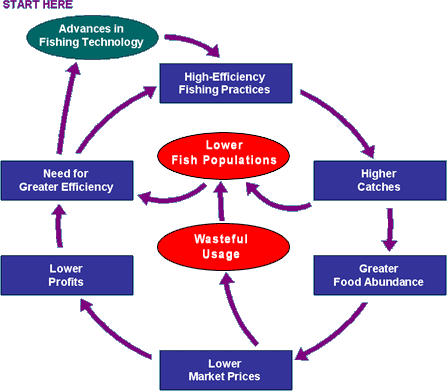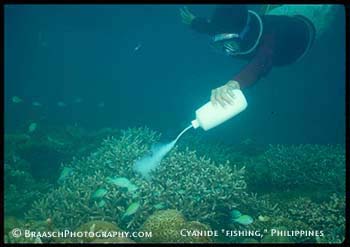Causes of Coral Reef Degradation
There are many reasons to the degradation of coral reefs, and they all play a role in contributing to the problem that reefs have to face in order to survive. Remember that all of these factors play a role on coral reef survival, and not just one particular reason. When they occur together, they can be very dangerous. Coral reefs are at a global decline and if action isn't taken then we are going to be left with no reefs, and a huge change in marine biodiversity, and in turn this will affect us.
Over-Harvesting of Fish
Damage done to coral reefs is at an all time high from humans going into coral reef areas for the high biodiversity species that live there and harvesting them. There are many dangerous fishing practices such as cyanide fishing, overfishing with nets, blast fishing, and reckless fishing. These are damaging reefs to the point where they cannot grow back (Jeremy 2013).
 |
| http://www.grinningplanet.com/2005/06-07/fishing-cycle.gif |
Overfishing is done by humans going in and just fishing too much so that the species present aren't sustainable. If too many of a species is taken out then they can't replenish themselves, and they die off. This isn't a route cause of dangers to Coral reefs, but paired along with different fishing methods it can be.
 |
| http://www.braaschphotography.com/indexphotos1/indexphotosh/077Endangered.jpg |
Cyanide fishing is done by fisherman shoot cyanide into coral areas with high numbers of the species they want to paralyze them so they can capture them relatively easily. Cyanide is poisonous to most animals, including humans, and can kill smaller fish and kill coral polyps, which are responsible for the main building of coral reefs (Coral Reef Alliance 2014).
 |
| http://oceanworld.tamu.edu/students/coral/images/dynamite_reef_1.jpg |
Blast fishing is another reckless fishing method. Explosives are thrown into the water and are detonated. This kills everything down there, including coral, and is a major problem (Coral Reef Alliance 2014).
 |
| http://nw08.american.edu/~vconn/seafood/images/Chalut%20de%20fond.jpeg |
| http://www.hookline-fishing.com/uploads/pics/pot-trap-fishing.jpg |
 |
| http://www.afma.gov.au/wp-content/uploads/2010/06/pelagic_longline.jpg?9370a8 |
Coral Mining
 |
| http://link.springer.com/static-content/images /135/prt%253A978-90-481-2639-2%252F11/MediaObjects /978-90-481-2639-2_11_Part_Fig1-115_HTML.jpg |
Pollution
 |
| http://coralreef.noaa.gov/threats/pollution/resources/plume_burdick.jpg |
Climate Change
With increasing heat in the climate this brings about many problems for reefs. Too much heat, and increasing levels of Carbon dioxide are becoming a major threat to Coral reefs world wide (Pandoli 2011).
 |
| Healthy Coral on left, and Damaged Coral From Ocean acidification on right. http://soundwaves.usgs.gov/2009/11/CoralF1TULG.jpg |
Ocean acidification is occuring due to the Carbon dioxide absorbed into the ocean from increasing levels in the atmosphere. This is increasing the pH of the ocean slightly which is causing major problems to coral, particularly to organisms that use shells. The increasing pH is causing shellfish and marine plankton to not be able to use carbonate as effectively (Pandoli 2011). Looking at coral polyps, they cannot form shells as easily because there are less and less carbonate to go around, and if they cannot form shells, they can't survive, and this slows the growth of coral reefs.
Coral bleaching is when coral polyps are stressed from the amount of heat they are having to deal with (Pandoli 2011). The polyps try to counter this by removing the algae that live inside them, but because this algae is responsible for almost the entire majority of their food supply, they can die.

No comments:
Post a Comment